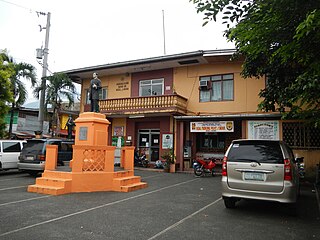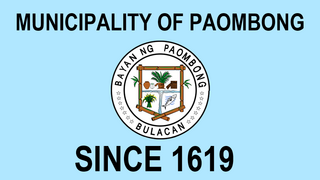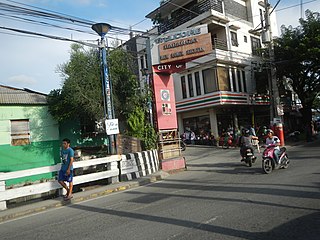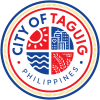
Makati, officially the City of Makati, is a highly urbanized city in the National Capital Region of the Philippines, known for being one of the leading financial centers in the country. As of 2013, the city has the highest concentration of multinational and local corporations in the Philippines. Major banks, corporations, department stores as well as foreign embassies are based in Makati. Makati is also known for being a major cultural and entertainment hub in Metro Manila. According to the 2020 census, it had a population of 629,616 people, making it as the 47th most populous city in the country and ranked as the 43rd most densely populated city in the world with 19,336 inhabitants per square kilometer or 50,080 inhabitants per square mile. In 2023, the 10 Embo barangays were removed from Makati's jurisdiction as a result of the Makati–Taguig boundary dispute ruling, resulting in a reduction of the city's population to about 292,743. The daytime population of the city is estimated to be more than three million during a typical working day because of the large number of people who go to the city to work, shop, and do business.

Rizal, officially the Province of Rizal, is a province in the Philippines located in the Calabarzon region in Luzon. Its capital is the city of Antipolo. It is about 16 kilometers (9.9 mi) east of Manila. The province is named after José Rizal, one of the main national heroes of the Philippines. It is bordered by Metro Manila to the west, Bulacan to the north, Quezon to the east and Laguna to the southeast. The province also lies on the northern shores of Laguna de Bay, the largest lake in the country. Rizal is a mountainous province perched on the western slopes of the southern portion of the Sierra Madre mountain range.

Rodriguez, officially the Municipality of Rodriguez and commonly known by its former name Montalban, is a 1st class urban municipality in the province of Rizal, Philippines. According to the 2020 census, it has a population of 443,954 people making it the most populous municipality in the country. Pending an affirmation through plebiscite, Republic Act No. 11812 repealed Batas Pambansa Blg. 275 and intend to formally revert to its original municipal name Montalban.

Pateros, officially the Municipality of Pateros, is the lone municipality of Metro Manila, Philippines. According to the 2020 census, it has a population of 65,227 people.

Taguig, officially the City of Taguig, is a coastal city located in eastern shores of Metro Manila. It is the fifth-most populous city in the Philippines with a population of 1.2 million people. The city is one of the Philippines' cultural, financial, high-tech, entertainment and media centers with significant influence on commerce, health care, research, technology, education, politics, tourism, dining, art, fashion, and sports. Taguig is also an important center for the country's international diplomacy, hosting several embassies. The city also home to the headquarters of several major multinational corporations. Taguig has the fourth largest skyline in the Philippines, with 289 high-rises, 80 of which exceed 100 m (328 ft).

Rizal, officially the Municipality of Rizal, is a 5th class municipality in the province of Laguna, Philippines. According to the 2020 census, it has a population of 18,332 people.

Baras, officially the Municipality of Baras, is a 4th class municipality in the province of Rizal, Philippines. According to the 2020 census, it has a population of 87,637 people.

Jalajala, officially the Municipality of Jalajala, is a 4th class municipality in the province of Rizal, Philippines. According to the 2020 census, it has a population of 34,017 people, making it the least populated municipality in the province.

Pililla, officially the Municipality of Pililla, is a 1st class municipality in the province of Rizal, Philippines. According to the 2020 census, it has a population of 71,535 people. It is surrounded by farms, small mountains, plains, and trees. Pililla is known as the Green Field Municipality of Rizal.

Dapitan, officially the City of Dapitan, is a 3rd class component city in the province of Zamboanga del Norte, Philippines. According to the 2020 census, it has a population of 85,202 people.

Guagua, officially the Municipality of Guagua, is a 1st class municipality in the province of Pampanga, Philippines. According to the 2020 census, it has a population of 128,893 people.

Hagonoy, officially the Municipality of Hagonoy, is a 1st class municipality in the province of Bulacan, Philippines. According to the 2020 census, it has a population of 133,448 people.

Paombong, officially the Municipality of Paombong, is a 3rd class municipality in the province of Bulacan, Philippines. According to the 2020 census, it has a population of 55,696 people.

Rizal, officially the Municipality of Rizal is a 2nd class municipality in the province of Nueva Ecija, Philippines. According to the 2020 census, it has a population of 70,196 people.
Metro Manila, the capital region of the Philippines, is a large metropolitan area that has several levels of subdivisions. Administratively, the region is divided into seventeen primary local government units with their own separate elected mayors and councils who are coordinated by the Metropolitan Manila Development Authority, a national government agency headed by a chairperson directly appointed by the Philippine president. The cities and municipality that form the region's local government units are further divided into several barangays or villages which are headed by an elected barangay captain and barangay council.

New Lower Bicutan, officially Barangay New Lower Bicutan, is one of the 38 barangays of Taguig, Metro Manila, Philippines. As of the 2020 census, the population was 55,928. The barangay was created through a plebiscite on December 28, 2008.

Bambang is one of the 38 barangays of Taguig, Metro Manila in the Philippines. One of the 9 initial Barrio of Taguig.

Central Signal Village, officially Barangay Central Signal Village and simply known as Central Signal, is one of the 38 barangays of Taguig, Metro Manila, Philippines. As of the 2020 census, the population was 44,126. The barangay was previously known as Signal Village, which was established on January 25, 1965, before it was renamed on December 28, 2008.

Taguig–Pateros's 1st congressional district is one of the two congressional districts of the Philippines in the combined independent local government units of Pateros and Taguig. It has been represented in the House of Representatives of the Philippines since 2007. The district was created in 2004 following a plebiscite to ratify Republic Act No. 8487 or the 1998 Taguig City Charter. It consists of the entire municipality of Pateros and the eastern Taguig barangays of Bagumbayan, Bambang, Calzada, Hagonoy, Ibayo-Tipas, Ligid-Tipas, Lower Bicutan, New Lower Bicutan, Napindan, Palingon, San Miguel, Santa Ana, Tuktukan, Ususan and Wawa. The district is currently represented in the 19th Congress by Ricardo S. Cruz Jr. of the Nacionalista Party (NP).

Embo, which stands for Enlisted Men's Barrio, refers to a collective term for ten barangays in Taguig, Philippines. The barangays were originally established to house military personnel of the Armed Forces of the Philippines (AFP). The area was formerly disputed between the cities of Makati and Taguig, as well as the municipality of Pateros. As of November 2023, the barangays were transferred from Makati to Taguig.


























